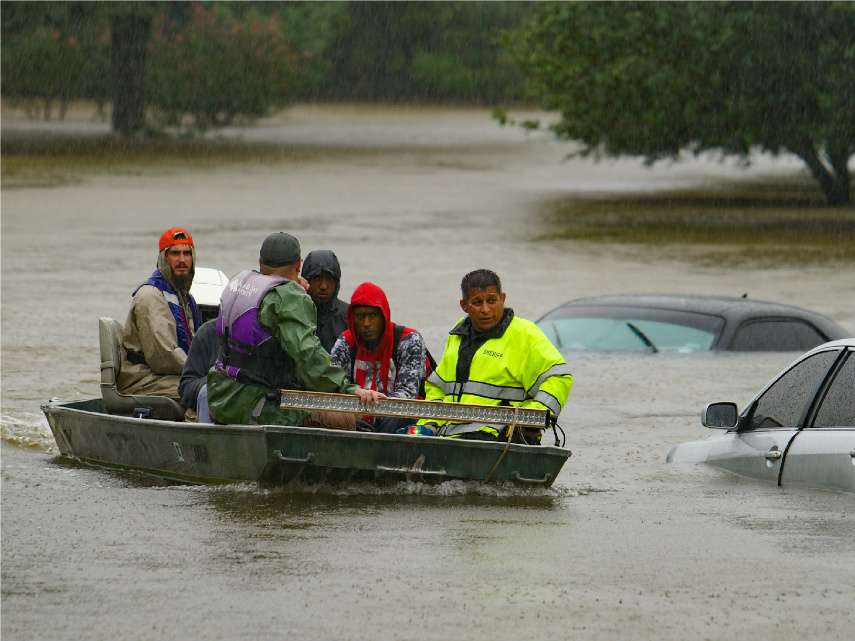Hurricane Harvey and Climate Change
Extreme weather events attribution science yields murky results

Rainfall from Hurricane Harvey so far has averaged around 30 inches, although the U.S. Weather Service projects that some areas of coastal Texas might receive as much as 50 inches before the slow moving storm exits the region.
Historically, Texas is no stranger to tropical storm inundation. In 1978 and 1979, the two wettest tropical cyclones on record, Amelia and Claudette respectively, dropped 48 and 42 inches of rain on coastal and central Texas.
Nevertheless, Hurricane Harvey has prompted some climatologists to assert that man-made climate change likely exacerbated the wind speed and moisture content of this tropical cyclone. Such claims are made based on the developing science in which researchers try to figure out how much man-made warming may have contributed to intensifying specific extreme weather events.
Last year the National Academies of Science (NAS) issued a report, Attribution of Extreme Weather Events in the Context of Climate Change that observed, "The science of extreme event attribution has advanced rapidly in recent years, giving new insight to the ways that human-caused climate change can influence the magnitude or frequency of some extreme weather events."
The NAS panel noted extreme event attribution science relies on the historical record to assess the change in probability or magnitude of various weather events and/or compares actual events with computer simulations of hypothetical worlds without climate change. The accuracy of such climate change attributions depends on judgments that the historical weather records are long enough to account for natural variability and confidence in the reliability of computer model projections.
Climate computer models suggest that hurricanes will increase in frequency and intensity should the planet warm over the course of this century. The NAS report, however, assigns "lower confidence" to making attributions about how climate change may be affecting hurricanes.
The 2017 draft of the U.S. Global Change Research Program Climate Science Special Report notes that "both theory and numerical modeling simulations (in general) indicate an increase in tropical cyclone (TC) intensity in a warmer world." Nevertheless, MIT hurricane researcher Kerry Emmanuel told AFP, "It is awfully difficult to see climate change in historical data so far because hurricanes are fairly rare." It is worth noting that the accumulated cyclone energy index measuring the kinetic energy of Atlantic hurricanes has been trending downward during the last ten years.
The 2017 Special Report further finds that trends with respect to floods in the U.S. are a mixed: They have increased in some regions and declined in others. The draft also observes that "attribution studies have not established a robust connection between increased riverine flooding and human-induced climate change."
A new study in the Journal of Hydrology analyzing long term flooding trends in North America and Western Europe finds no discernible increase in floods in those areas during the past 80 years. A team led U.S. Geological Survey researcher Glenn Hodgkins reported, "There was no compelling evidence for consistent changes over time in major-flood occurrence during the 80 years through 2010, using a very large dataset (>1200 gauges) of diverse but minimally altered catchments in North America and Europe." The researchers added, "For North America and Europe, the results provide a firmer foundation for the IPCC [Intergovernmental Panel on Climate Change] finding that compelling evidence for increased flooding at a global scale is lacking."
The 2014 National Climate Assessment reported, "The heaviest rainfall events have become heavier and more frequent, and the amount of rain falling on the heaviest rain days has also increased." Interestingly, a 2016 study by researchers at National Oceanic and Atmospheric Administration's Geophyiscal Fluid Dynamics Laboratory looked for precipitation trends over the contiguous United States. They reported that "no evidence was found for changes in extreme precipitation attributable to climate change in the available observed record."
Ultimately the concern about hurricanes is the risk they pose to lives and property. Sadly, Hurricane Harvey is reportedly responsible for 14 deaths so far and one estimate places property damage from the storm at $40 billion. According to the National Weather Service, deaths attributed to hurricanes have averaged 5 per year since 2007.
So what about hurricane damages? A 2015 study in Nature Geoscience argued that some economic losses from hurricanes striking the United States are "consistent with an influence of climate change." On the other hand, after normalizing damages by taking increases in population and wealth into account, many other researchers have concluded that so far anthropogenic climate change has not significantly increased losses from weather disasters.
In a 2008 analysis, Colorado University environmental policy researcher Roger Pielke Jr. and his colleagues similarly reported that between 1900 and 2005 there was no trend toward increasing losses from hurricanes in the United States. Updated through 2013, Pielke found that normalized losses from hurricanes in the United States are still not rising.
Last month, Pielke observed, "The world has had a run of good luck when it comes to weather disasters. That will inevitably come to an end." Time will tell if Harvey is a signal that our run of good luck has ended.


Show Comments (206)